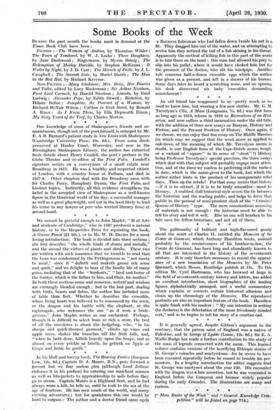* * * *
. We cannot be grateful enough to John Maplet, " M of Arte and studente of Cambridge," who in 1567 produced a natural history, or to the Hesperides Press for reprinting the book, A Greene Forest (11 10s.), or to Mr. W. H. Davies for a most loving introduction. The book is divided into three sections ; the first describes " the wholle kinde of stones and metals," and the second the virtues of plants and shrubs. These two are written with such assurance that we tremble to read that the bean was condemned by the Pythagoreans as " not meete to meat," since it " dulleth and maketh grosse ech sense and spirit," and we delight to hear of the family life of many gems, including that of the " Sardonix," " bred and borne of the Sardye, which is the father to him, and Onix, his mother." In both these sections sense and nonsense, naivete and wisdom are cunningly blended enough ; but in the last part, dealing with birds, beasts and fishes, the author has included more of fable than fact. Whether he describes the crocodile, whose living heart was believed to be consumed by the wren, or the dragon and his battle with the elephant, or the nightingale, who welcomes the sun " as it were a bride- groome," John Maplet writes as one enchanted. Perhaps, though it is difficult to select from so rich a store, the best of all the anecdotes is about the hedgehog, who, " in his sharpe and quick-thorned garment," climbs up vines and apple trees, shakes the branches till the fruit falls, and, "when he bath done, falleth heavily upon the heape, and so almost on every prickle or bristle, he getteth an Apple or Grape and home he goeth."




































 Previous page
Previous page